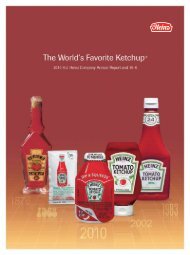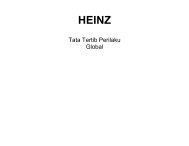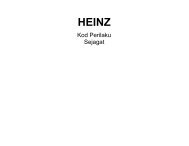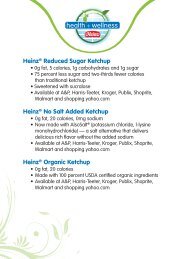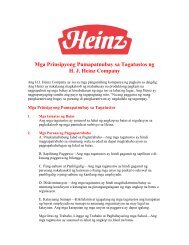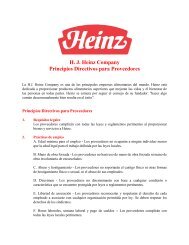ANYTIMEkANYPLACEkANYWHERE - Heinz
ANYTIMEkANYPLACEkANYWHERE - Heinz
ANYTIMEkANYPLACEkANYWHERE - Heinz
Create successful ePaper yourself
Turn your PDF publications into a flip-book with our unique Google optimized e-Paper software.
NOTES TO CONSOLIDATED FINANCIAL STATEMENTS<br />
H.J. <strong>Heinz</strong> Company and Subsidiaries<br />
1. SIGNIFICANT<br />
ACCOUNTING POLICIES<br />
Fiscal Year: H.J. <strong>Heinz</strong> Company (the ‘‘company’’) operates on a 52- or 53-week fiscal year<br />
ending the Wednesday nearest April 30. However, certain foreign subsidiaries have earlier<br />
closing dates to facilitate timely reporting. Fiscal years for the financial statements included<br />
herein ended May 3, 2000, April 28, 1999 and April 29, 1998.<br />
Principles of Consolidation: The consolidated financial statements include the accounts<br />
of the company and its subsidiaries. All intercompany accounts and transactions were<br />
eliminated. Investments owned less than 50%, where significant influence exists, are accounted<br />
for on an equity basis. Certain prior-year amounts have been reclassified in order to conform<br />
with the Fiscal 2000 presentation.<br />
UseofEstimates:The preparation of financial statements, in conformity with generally accepted<br />
accounting principles, requires management to make estimates and assumptions that affect<br />
the reported amounts of assets and liabilities, the disclosure of contingent assets and liabilities<br />
at the date of the financial statements, and the reported amounts of revenues and expenses<br />
during the reporting period. Actual results could differ from these estimates.<br />
Translation of Foreign Currencies: For all significant foreign operations, the functional currency<br />
is the local currency. Assets and liabilities of these operations are translated at the exchange<br />
rate in effect at each year-end. Income statement accounts are translated at the average rate of<br />
exchange prevailing during the year. Translation adjustments arising from the use of differing<br />
exchange rates from period to period are included as a component of shareholders’ equity.<br />
Gains and losses from foreign currency transactions are included in net income for the period.<br />
Cash Equivalents: Cash equivalents are defined as highly liquid investments with original<br />
maturities of 90 days or less.<br />
Inventories: Inventories are stated at the lower of cost or market. Cost is determined principally<br />
under the average cost method.<br />
Property, Plant and Equipment: Land, buildings and equipment are recorded at cost. For<br />
financial reporting purposes, depreciation is provided on the straight-line method over<br />
the estimated useful lives of the assets. Accelerated depreciation methods are generally used<br />
for income tax purposes. Expenditures for new facilities and improvements that substantially<br />
extend the capacity or useful life of an asset are capitalized. Ordinary repairs and maintenance<br />
are expensed as incurred. When property is retired or otherwise disposed, the cost and<br />
related depreciation are removed from the accounts and any related gains or losses are<br />
included in income.<br />
Intangibles: Goodwill, trademarks and other intangibles arising from acquisitions are being<br />
amortized on a straight-line basis over periods ranging from three to 40 years. The company<br />
regularly reviews the individual components of the balances by evaluating the future cash<br />
flows of the businesses to determine the recoverability of the assets and recognizes, on a<br />
current basis, any diminution in value.<br />
(51)





